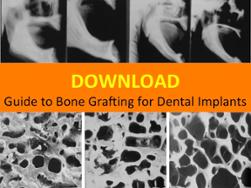Share this
What is the cost of bone grafting for dental implants in Singapore?
on June 14, 2016
 Today, dental implants are the teeth replacement of choice. However, there are many instances whereby dental implants cannot be done, at least not without bone grafting. Dental implants are inserted into bone to support a dental prosthesis. If that part of the jaw bone is deficient in bone mass, it will need to be augmented before an implant can be placed. This adds to the overall cost of the treatment. Depending on the type of bone graft, the volume needed, and the technique used, the cost of bone grafting can add significantly to the overall cost of having dental implants in Singapore.
Today, dental implants are the teeth replacement of choice. However, there are many instances whereby dental implants cannot be done, at least not without bone grafting. Dental implants are inserted into bone to support a dental prosthesis. If that part of the jaw bone is deficient in bone mass, it will need to be augmented before an implant can be placed. This adds to the overall cost of the treatment. Depending on the type of bone graft, the volume needed, and the technique used, the cost of bone grafting can add significantly to the overall cost of having dental implants in Singapore.
- Source of bone graft
The bone to be added to the deficient jaw can be obtained from various sources. It can be sourced from the patient’s own bone or it can be bought through commercial companies that process human or animal bone. The bone graft can also be purely synthetic
- Autogenous bone: this is bone from the patient’s own body. This is the gold standard of bone graft. Depending on the volume of bone required, the donor site differs. Small quantities can be harvested from the other parts of the jaw itself, typically from the chin and ramus (the back part of the lower jaw). Larger quantities are often harvested from the hip bone.
- Chin: harvesting bone from the chin or other intraoral sites are usually done in the clinic under local anaesthesia and intravenous sedation. Cost may range from $1500-3000, depending on the volume needed.
- Hip: harvesting of bone from the hip must be done under general anesthesia in a hospital operating theatre. As such, a lot more resources are used. It can be done as a day surgery procedure, ie no overnight stay in the hospital is needed, but some patients do opt to stay one night in the hospital. Cost of this surgery is about $10000.
- Human /Animal: Commercial companies process bone from human and animals such as cows and horses and package them into bottles of sterilized bone. This process involves removing the organic components of the bone, leaving the mineral structure. The bone is then cut into various shapes and sizes, packed into glass bottles and sterilized. When used for dental implant treatment, they are placed onto the deficient jaw bone where they function as a scaffold for the patient’s new bone to grow into them. Unlike autogenous bone, this type of graft material does not have the ability to induce new bone formation but it allows new bone to grow through them. Cost of this material varies from supplier to supplier. On average, 0.25cc of bone graft may cost about $300.
- Synthetic : With a human or animal donor, there is limitation of numbers as well as potential transmission of diseases, at least theoretically. Using a purely synthetic bone graft such as tricalcium phosphate virtually removes such limitations. Such synthetic bone graft, like human and animal donor bone, is also not able to induce new bone formation but purely allows new bone to grow through them. Cost of such synthetic bone is quite similar to that of donor bone.
- Synthetic osteoinductive bone: However, there is a relatively new synthetic bone graft material known as bone morphogenetic protein that is able to induce new bone formation. Bone morphogenetic protein is normal found in our bone and is able to stimulate new bone formation. Using recombinant DNA technology, this protein can be synthesized in the laboratory. This protein, when mixed with a carrier like donor bone, can functional almost like autogenous bone, having both osteoinductive and conductive properties. Cost, however, is rather prohitibitive, ranging from $2000-10000, depending on the quantity needed.
- Technique of bone grafting
- Onlay grafting: An incision is made on the gum and the gum is stripped from the bone. The exposed jaw bone is then perforated with a drill to induce bleeding. The bone graft, in the form of a block, is placed onto the recipient bone directly and secured with two screws. Additional bone graft material in the form of granules, are packed into the voids between the block graft and the recipient bone. The gum is then stitched back to cover the graft. Over the course of the next four to six months, new bone will form from the jaw bone into the graft, integrating them together. Cost of onlay bone grafting ranges from $1000 to $3000
- Guided bone regeneration: This is similar to onlay grafting except that bone graft used is in the form of granules and they are packed onto the recipient bone. In granular form, new bone formation penetrates the graft better, giving better integration of the bone. However, it requires a special collagen membrane to wrap around it to prevent the particles from spilling all over and to prevent ingress of fibrous tissue that will weaken the graft. Cost of guided bone regeneration is similar to onlay grafting but with the added cost of the membrane. Such membranes cost ranges from $300-1000, depending on size.
- Sinus lift: For the back part of the upper jaw, bone grafting is often done on the top part of the jaw instead, which is the floor of the maxillary sinus. Once the back teeth are lost, the sinus, which is an air chamber above the upper jaw, start to expand downwards, reducing the thickness of the bone. Surrounding this air chamber (sinus) is a lining. By opening a window on the side of the sinus without cutting into the lining, the lining is lifted away from the floor of the sinus and bone is packed into the space. This procedure of lifting the lining and placing bone between the lining and bone is called sinus lift. Average cost of this procedure is $2000.
- Sandwich bone grafting: One of the downsides of onlay bone graft and guided bone regeneration is that the source of new bone comes from only one direction. This often results in a less than ideal result. By splitting the recipient site open and packing the bone graft in between, the graft is surrounded on both sides and new bone can grow into the graft from both sides. This method of “sandwiching” the bone graft gives a better result but it requires sufficient thickness of pre-existing bone to enable splitting and is a more invasive procedure. The entire upper jaw can be separated from the base of the skull and bone grafts “sandwiched” in between. Alternatively, the bone of one single tooth can also be split and bone graft sandwiched in between. A large “sandwich” involving the whole jaw must be done under general anesthesia in the hospital while a more small area can be managed in the clinic under intravenous sedation. Cost may range from $20,000 for a full arch sandwich bone graft to $1000 for a single tooth augmentation.
3. Choice of anesthesia. Some of the surgical techniques above mandates the use of general anesthesia in a hospital operating theater while others can be done in the clinic. However, in the latter group of procedures, general anesthesia is sometimes chosen by patients due to fear of long dental procedures. If general anesthesia is chosen by the patient, cost of hospital and anesthetist will be incurred and that will push up the overall cost significantly.
In summary, there are many variables in grafting techniques and sources of bone which will determine the final cost of bone grafting in Singapore.
Share this
- Jaw Surgery (93)
- Dental Implants Singapore (90)
- Orthognathic Surgery (48)
- Replacing Missing Teeth (26)
- Missing Teeth Options (23)
- Underbite (23)
- Bone Grafting (21)
- Costs (18)
- Facial Aesthetics (18)
- Aesthetics (17)
- dental implants (16)
- corrective jaw surgery (15)
- BOTOX (11)
- Dermal Fillers (11)
- Wisdom teeth (10)
- Fixed Implant Dentures (8)
- Loose Dentures Singapore (6)
- Medisave (6)
- sleep apnea (6)
- Braces (5)
- Dental Pain (5)
- Dentures in Singapore (5)
- Loose Teeth (5)
- Tooth Extraction (5)
- jaw deformities (5)
- bimax (4)
- bone graft (4)
- maxillomandibular advancement (4)
- all-on-4 (3)
- bimaxillary protrusion (3)
- chin implant (3)
- facial asymmetry (3)
- full mouth dental implants (3)
- genioplasty (3)
- immediate implant (3)
- removal of an integrated dental implant (3)
- third molars (3)
- wisdom tooth surgery (3)
- My Dentures Don't Fit (2)
- VME (2)
- bone graft healing (2)
- distraction osteogenesis (2)
- medical tourism (2)
- obstructive sleep apnea (2)
- orthodontics (2)
- plastic surgery (2)
- CT guided dental implants (1)
- Double jaw surgery (1)
- Invisalign (1)
- Periodontal Disease (1)
- Permanent Dentures Singapore (1)
- before and after photos (1)
- facial trauma (1)
- fractured dental implant (1)
- oral appliance therapy (1)
- root canal treatment (1)
- veneers (1)
- vertical maxillary excess (1)
- September 2019 (2)
- July 2019 (2)
- May 2019 (2)
- August 2018 (1)
- October 2017 (1)
- September 2017 (2)
- August 2017 (1)
- June 2017 (2)
- May 2017 (4)
- April 2017 (1)
- March 2017 (1)
- February 2017 (3)
- January 2017 (3)
- December 2016 (1)
- November 2016 (2)
- October 2016 (4)
- September 2016 (9)
- August 2016 (5)
- July 2016 (11)
- June 2016 (14)
- May 2016 (6)
- April 2016 (2)
- March 2016 (1)
- January 2016 (7)
- December 2015 (10)
- November 2015 (4)
- October 2015 (9)
- September 2015 (7)
- August 2015 (1)
- July 2015 (6)
- June 2015 (3)
- May 2015 (7)
- April 2015 (5)
- March 2015 (8)
- January 2015 (5)
- December 2014 (7)
- November 2014 (7)
- October 2014 (6)
- September 2014 (8)
- August 2014 (5)
- July 2014 (7)
- June 2014 (8)
- May 2014 (9)
- April 2014 (10)
- March 2014 (6)
- February 2014 (8)
- January 2014 (3)
Subscribe by email
Email subscription




Comments (1)